
Here you can study for the exam. Look up keywords and learn definitions about all kind of subjects.
More subjects
Portulaca grandiflora is a succulent flowering plant in the family Portulacaceae, native to southern Brazil, Argentina, and Uruguay and often cultivated in gardens. It has many common names, including rose moss, eleven o'clock, Mexican rose, moss rose, sun rose, rock rose, and moss-rose purslane. It is a small, but fast-growing annual plant growing to 30 cm tall, though usually less. However, if it is cultivated properly, it can easily reach this height. The leaves are thick and fleshy, up to 2.5 cm long, arranged alternately or in small clusters. The flowers are 2.5–3 cm diameter with five petals, variably red, orange, pink, white, and yellow. Their upright, or ascending, long shoots branch usually near the base. The spreading 20-to-25-millimeters-long and 2-to-3-millimeters-wide leaves are almost or completely stalk-shaped, and taper towards the tip. (Source: Wikipedia.org, CC BY-SA)
Calendula officinalis, the pot marigold, common marigold, ruddles, Mary's gold or Scotch marigold, is a flowering plant in the daisy family Asteraceae. It is probably native to southern Europe, though its long history of cultivation makes its precise origin unknown, and it may possibly be of garden origin.[clarification needed] It is also widely naturalised farther north in Europe (as far as southern England) and elsewhere in warm temperate regions of the world. Calendula officinalis is a short-lived aromatic herbaceous perennial, growing to 80 cm (31 in) tall, with sparsely branched lax or erect stems. The leaves are oblong-lanceolate, 5–17 cm (2–7 in) long, hairy on both sides, and with margins entire or occasionally waved or weakly toothed. The inflorescences are yellow, comprising a thick capitulum or flowerhead 4–7 cm (1+1⁄2–3 in) diameter surrounded by two rows of hairy bracts; in the wild plant they have a single ring of ray florets surrounding the central disc florets. The disc florets are tubular and hermaphrodite, and generally of a more intense orange-yellow colour than the female, tridentate, peripheral ray florets. The flowers may appear all year long where conditions are suitable. The fruit is a thorny curved achene and weight in average 10.1 mg (n=50).[citation needed] (Source: Wikipedia.org, CC BY-SA)
Mimosa strigillosa, also known as sunshine mimosa and powderpuff, is a perennial ground cover in the family Fabaceae that is native to nearly all US states bordering the Gulf of Mexico and grows north into Georgia and Arkansas as well. The name powderpuff refers to the small spherical flowers that rise above the plant's creeping vines. Like related species in the genus Mimosa, sunshine mimosa has sensitive leaves that can fold in a matter of seconds after being disturbed. (Source: Wikipedia.org, CC BY-SA)
Primula (/ˈprɪmjʊlə/) is a genus of herbaceous flowering plants in the family Primulaceae. They include the primrose (P. vulgaris), a familiar wildflower of banks and verges. Other common species are P. auricula (auricula), P. veris (cowslip), and P. elatior (oxlip). These species and many others are valued for their ornamental flowers. They have been extensively cultivated and hybridised (in the case of the primrose, for many hundreds of years). Primula are native to the temperate Northern Hemisphere, south into tropical mountains in Ethiopia, Indonesia, and New Guinea, and in temperate southern South America. Almost half of the known species are from the Himalayas. (Source: Wikipedia.org, CC BY-SA)
Echinacea purpurea, the eastern purple coneflower, purple coneflower, hedgehog coneflower, or echinacea, is a North American species of flowering plant in the family Asteraceae. It is native to parts of eastern North America and present to some extent in the wild in much of the eastern, southeastern and midwestern United States as well as in the Canadian Province of Ontario. It is most common in the Ozarks and in the Mississippi/Ohio Valley. Its habitats include dry open woods, prairies and barrens. Echinacea purpurea is an herbaceous perennial up to 120 cm (47 in) tall by 25 cm (10 in) wide at maturity. Depending on the climate, it blooms throughout summer into autumn. Its cone-shaped flowering heads are usually, but not always, purple in the wild. Its individual flowers (florets) within the flower head are hermaphroditic, having both male and female organs in each flower. It is pollinated by butterflies and bees. The alternate leaves, borne by a petiole from 0 to 17 cm, are oval to lanceolate, 5-30 x 5-12 cm; the margin is tightened to toothed. (Source: Wikipedia.org, CC BY-SA)
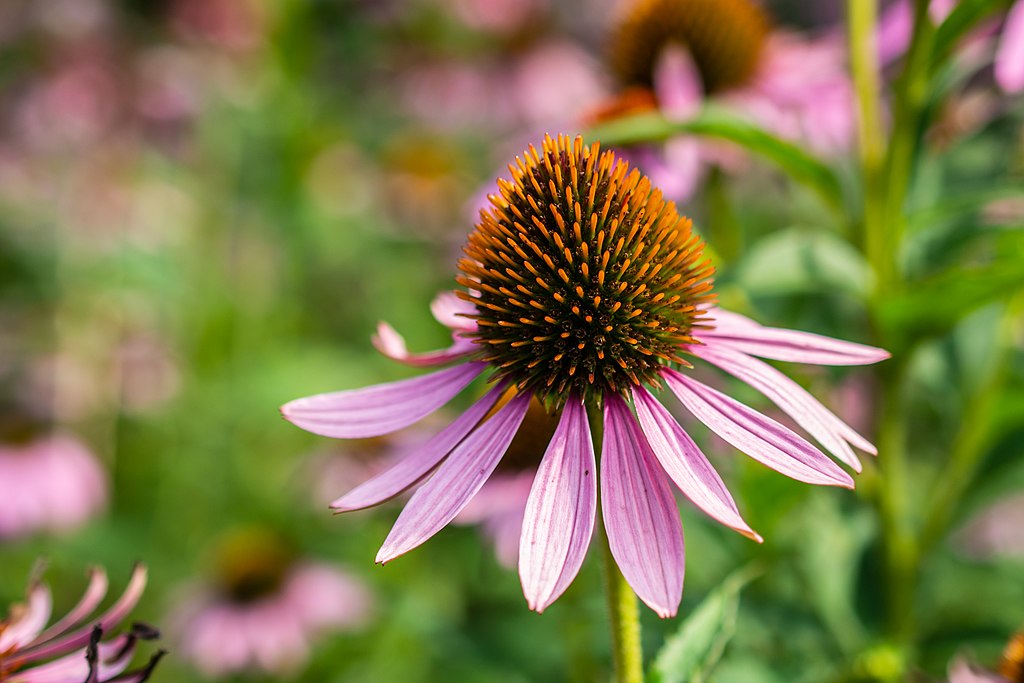 © Wikimedia.org/Jg44.89, CC BY
© Wikimedia.org/Jg44.89, CC BY
Houstonia caerulea, commonly known as azure bluet, Quaker ladies, or bluets, is a perennial species in the family Rubiaceae. It is native to eastern Canada (Ontario to Newfoundland) and the eastern United States (Maine to Wisconsin, south to Florida and Louisiana, with scattered populations in Oklahoma). It is found in a variety of habitats such as cliffs, alpine zones, forests, meadows and shores of rivers or lakes. Houstonia caerulea is a perennial herb that produces showy flowers approximately 1 cm across. These flowers are four-parted with pale blue petals and a yellow center. The foliage is a basal rosette with spatula-shaped leaves. Stems are up to 20 cm tall with one flower per stalk. Leaves are simple and opposite in arrangement with two leaves per node along the stem. It thrives in moist acidic soils in shady areas, growing especially well among grasses. (Source: Wikipedia.org, CC BY-SA)
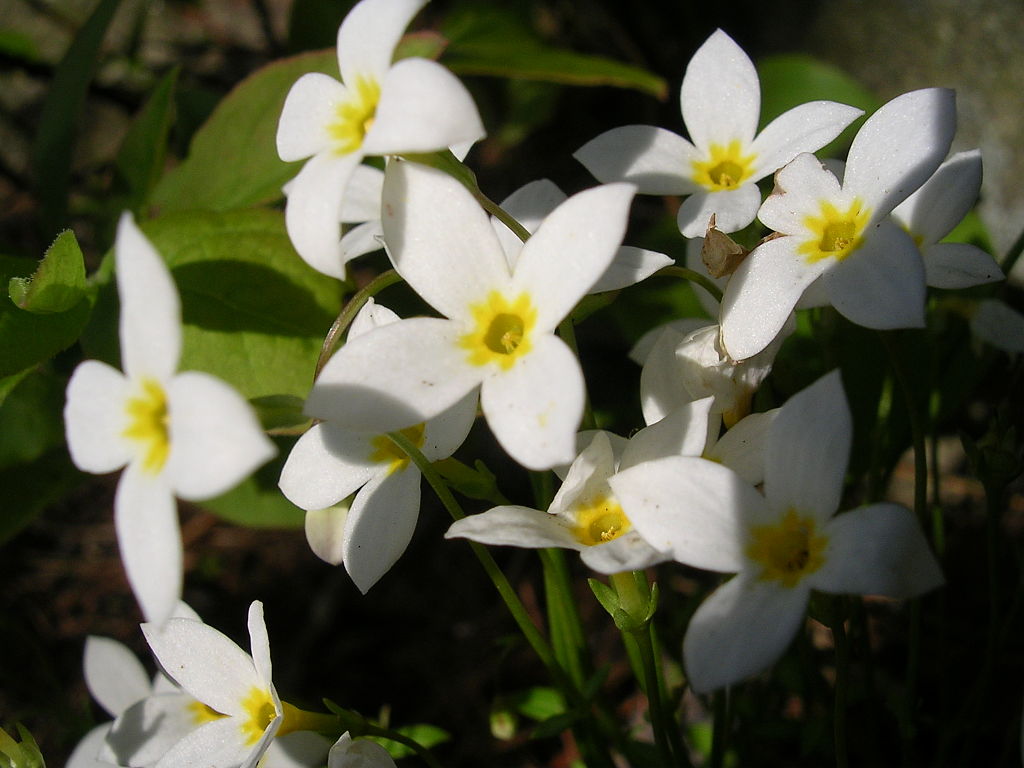 © Wikimedia.org/J. Carmichael, CC0
© Wikimedia.org/J. Carmichael, CC0
Anthriscus sylvestris, known as cow parsley, wild chervil, wild beaked parsley, Queen Anne's lace or keck, is a herbaceous biennial or short-lived perennial plant in the family Apiaceae (Umbelliferae), genus Anthriscus. It is also sometimes called mother-die (especially in the UK), a name that is also applied to the common hawthorn. It is native to Europe, western Asia and northwestern Africa. It is related to other diverse members of Apiaceae, such as parsley, carrot, hemlock and hogweed. It is often confused with Daucus carota, another member of the Apiaceae also known as 'Queen Anne's lace' or 'wild carrot'. (Source: Wikipedia.org, CC BY-SA)
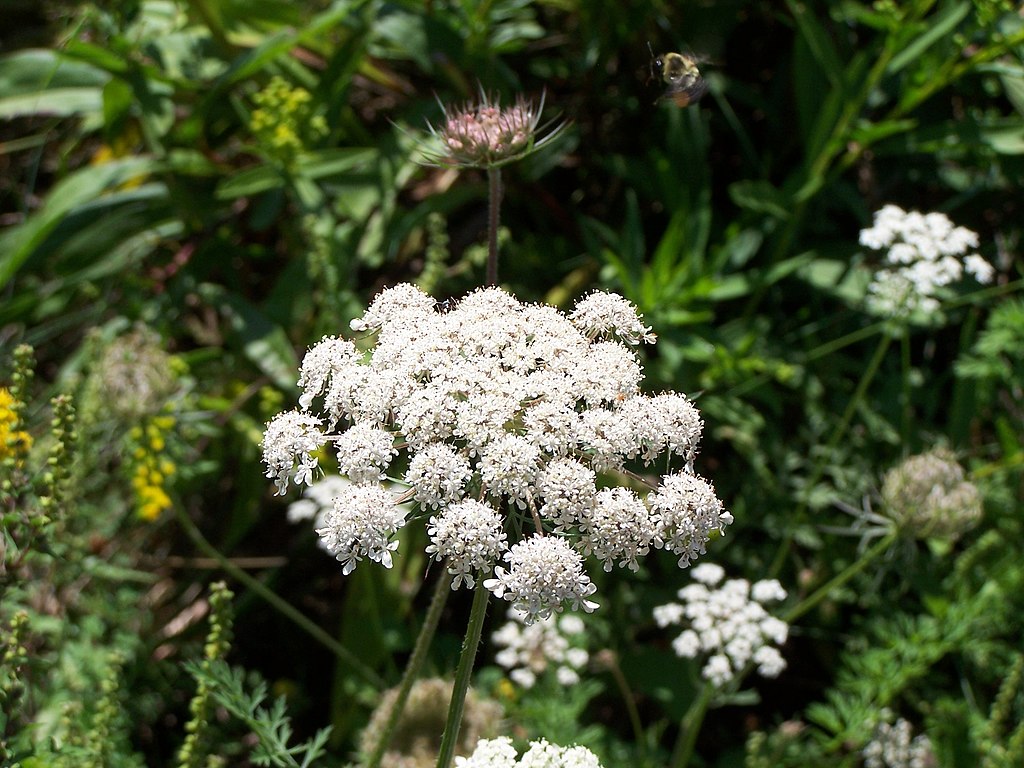 © Wikimedia.org/Crispins C. Crispian, CC BY-SA
© Wikimedia.org/Crispins C. Crispian, CC BY-SA
Filipendula ulmaria, commonly known as meadowsweet or mead wort, is a perennial herbaceous plant in the family Rosaceae that grows in damp meadows. It is native throughout most of Europe and Western Asia (Near east and Middle east). It has been introduced and naturalised in North America. Meadowsweet has also been referred to as queen of the meadow, pride of the meadow, meadow-wort, meadow queen, lady of the meadow, dollof, meadsweet, and bridewort. The stems, growing up to 120 cm, are 1–2 m (3.3–6.6 ft) tall, erect and furrowed, reddish to sometimes purple. The leaves are dark-green on the upper side and whitish and downy underneath, much divided, interruptedly pinnate, having a few large serrate leaflets and small intermediate ones. Terminal leaflets are large, 4–8 cm long, and three- to five-lobed. Meadowsweet has delicate, graceful, creamy-white flowers clustered close together in irregularly-branched cymes, having a very strong, sweet smell redolent of antiseptic. They flower from early summer to early autumn and are visited by various types of insects, in particular Musca flies. (Source: Wikipedia.org, CC BY-SA)
Clintonia uniflora, commonly known as bride's bonnet, queen's cup, or bead lily, is a species of flowering plant in the lily family Liliaceae. The specific epithet uniflora means 'one-flowered', a characteristic that distinguishes this species from others in the genus Clintonia. For this reason, it is also known as the single-flowered clintonia. Clintonia uniflora is a perennial herbaceous plant that spreads by means of underground rhizomes. It is the smallest plant in the genus, only 15 to 25 cm (6 to 10 in) tall. It has two or three leaves located at the base of a hairy stem. Each leaf is 2.5 to 6.5 cm (1 to 3 in) wide and 8 to 20 cm (3 to 8 in) long. A plant typically bears a single flower but occasionally there will be an inflorescence of two flowers. The small flower has six white tepals, each approximately 2 cm (0.8 in) long, and six protruding white stamens with pollen-dusted anthers. After pollination, the flower is replaced by a round blue berry approximately 1 cm (0.4 in) in diameter. (Source: Wikipedia.org, CC BY-SA)
The quince (/ˈkwɪns/; Cydonia oblonga) is the sole member of the genus Cydonia in the Malinae subtribe (which also contains apples and pears, among other fruits) of the Rosaceae family. It is a deciduous tree that bears hard, aromatic bright golden-yellow pome fruit, similar in appearance to a pear. Ripe quince fruits are hard, tart, and astringent. They are seldom eaten raw, but are processed into marmalade, jam, paste (known as quince cheese) or alcoholic beverages. The quince tree is also grown as an ornamental plant for its attractive pale pink blossoms and other ornamental qualities. (Source: Wikipedia.org, CC BY-SA)
Zephyranthes /ˌzɛfɪˈrænθiːz/ is a genus of temperate and tropical plants in the Amaryllis family, subfamily Amaryllidoideae, native to the Western Hemisphere and widely cultivated as ornamentals. Following the expansion of the genus in 2019, which now includes the genera Habranthus and Sprekelia, there are about 200 recognized species, as well as numerous hybrids and cultivars. Common names for species in this genus include fairy lily, rainflower, zephyr lily, magic lily, Atamasco lily, and rain lily. (Source: Wikipedia.org, CC BY-SA)
Ranunculus /ræˈnʌŋkjʊləs/ is a large genus of about almost 1700 to more than 1800 species of flowering plants in the family Ranunculaceae. Members of the genus are known as buttercups, spearworts and water crowfoots. The genus is distributed in Europe, North America and South America. The familiar and widespread buttercup of gardens throughout Northern Europe (and introduced elsewhere) is the creeping buttercup Ranunculus repens, which has extremely tough and tenacious roots. Two other species are also widespread, the bulbous buttercup Ranunculus bulbosus and the much taller meadow buttercup Ranunculus acris. In ornamental gardens, all three are often regarded as weeds. Buttercups usually flower in the spring, but flowers may be found throughout the summer, especially where the plants are growing as opportunistic colonizers, as in the case of garden weeds. (Source: Wikipedia.org, CC BY-SA)
Portulaca grandiflora is a succulent flowering plant in the family Portulacaceae, native to southern Brazil, Argentina, and Uruguay and often cultivated in gardens. It has many common names, including rose moss, eleven o'clock, Mexican rose, moss rose, sun rose, rock rose, and moss-rose purslane. It is a small, but fast-growing annual plant growing to 30 cm tall, though usually less. However, if it is cultivated properly, it can easily reach this height. The leaves are thick and fleshy, up to 2.5 cm long, arranged alternately or in small clusters. The flowers are 2.5–3 cm diameter with five petals, variably red, orange, pink, white, and yellow. Their upright, or ascending, long shoots branch usually near the base. The spreading 20-to-25-millimeters-long and 2-to-3-millimeters-wide leaves are almost or completely stalk-shaped, and taper towards the tip. (Source: Wikipedia.org, CC BY-SA)
Rondeletia is a genus of flowering plants in the family Rubiaceae. It is endemic to the Neotropics. There are around 160 species. Rondeletia odorata is widely grown as an ornamental. Several other species are also known in cultivation. The circumscription of Rondeletia has varied greatly from one author to another. Rogiera, Arachnothryx, and a few others have been included in Rondeletia by some authors, but molecular phylogenetic studies have shown that they are closer to Guettarda than to Rondeletia, and they are now recognized as separate genera. Even with these segregates removed, Rondeletia remains polyphyletic and will be substantially revised after further phylogenetic study. (Source: Wikipedia.org, CC BY-SA)
A rose is either a woody perennial flowering plant of the genus Rosa (/ˈroʊzə/), in the family Rosaceae (/roʊˈzeɪsiːˌiː/), or the flower it bears. There are over three hundred species and tens of thousands of cultivars.[citation needed] They form a group of plants that can be erect shrubs, climbing, or trailing, with stems that are often armed with sharp prickles.[citation needed] Their flowers vary in size and shape and are usually large and showy, in colours ranging from white through yellows and reds. Most species are native to Asia, with smaller numbers native to Europe, North America, and northwestern Africa.[citation needed] Species, cultivars and hybrids are all widely grown for their beauty and often are fragrant. Roses have acquired cultural significance in many societies. Rose plants range in size from compact, miniature roses, to climbers that can reach seven meters in height.[citation needed] Different species hybridize easily, and this has been used in the development of the wide range of garden roses. (Source: Wikipedia.org, CC BY-SA)
Rose of Sharon is a name that has been applied to several different species of flowering plants that are valued in different parts of the world. It is also a biblical expression, though the identity of the plant referred to is unclear and is disputed among biblical scholars. In neither case does it refer to actual roses, although one of the species it refers to in modern usage is a member of Rosaceae. The deciduous flowering shrub known as the rose of Sharon is a member of the mallow family which is distinct from the family Rosaceae. The name's colloquial application has been used as an example of the lack of precision of common names, which can potentially cause confusion. 'Rose of Sharon' has become a frequently used catch phrase in poetry and lyrics.[citation needed] (Source: Wikipedia.org, CC BY-SA)
Salvia splendens, the scarlet sage, is a tender herbaceous perennial plant native to Brazil, growing at 2,000 to 3,000 m (6,600 to 9,800 ft) elevation where it is warm year-round and with high humidity. The wild form, rarely seen in cultivation, reaches 1.3 m (4.3 ft) tall. Smaller cultivars are very popular as bedding plants, seen in shopping malls and public gardens all over the world. The native type is rarely used or described, though it grew from 1.5 to 8 m (4.9 to 26.2 ft) in height. Its leaves are in even, elliptical arrangements, 7 × 5 cm, with dentate margin and they have long petioles. It may branched, where its upper branches are finely hairy and in the lower parts though hairless. Flowers in erect spikes that sprout from the centre of the plant in groups of 2 to 6 together in each leaf node; scarlet, tubular or bell-shaped, 35 mm long, with two lobes towards the apex; the upper lobe is 13 mm long. It flowers a good part of summer and autumn. (Source: Wikipedia.org, CC BY-SA)
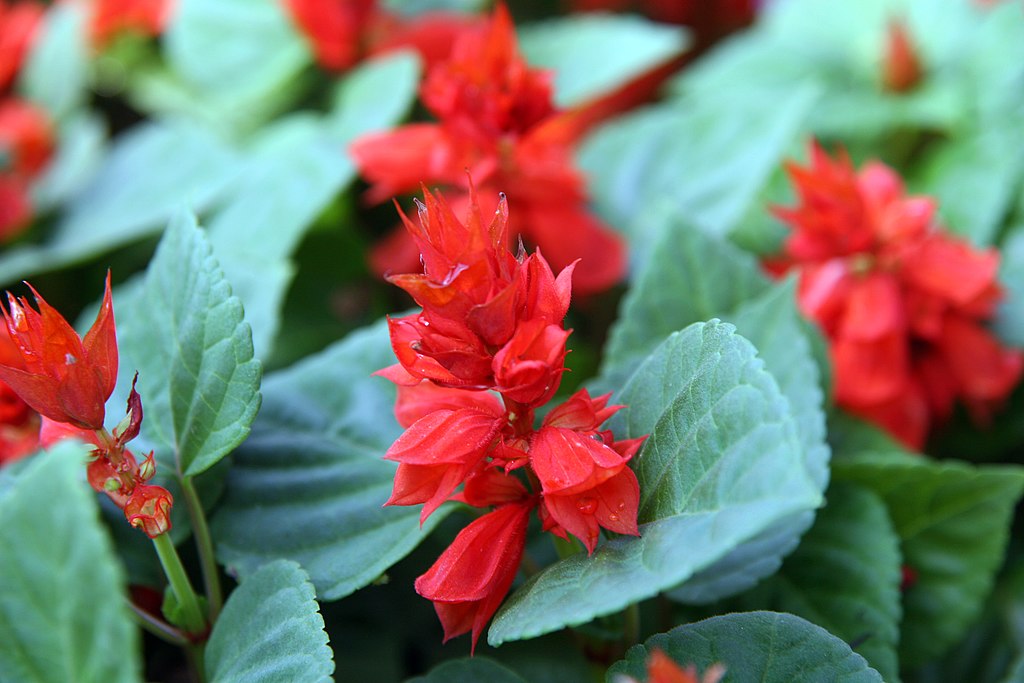 © Wikimedia.org/David J. Stang, CC BY-SA
© Wikimedia.org/David J. Stang, CC BY-SA
Saponaria is a genus of flowering plants in the family Caryophyllaceae, native to Asia and Europe, and are commonly known as soapworts. They are herbaceous perennials and annuals, some with woody bases. The flowers are abundant, five-petalled and usually in shades of pink or white. The genus is closely related to Lychnis and Silene, being distinguished from these by having only two (not three or five) styles in the flower. It is also related to Gypsophila, but its calyx is cylindrical rather than bell-shaped. (Source: Wikipedia.org, CC BY-SA)
Scabiosa /skeɪbiˈoʊsə/ is a genus in the honeysuckle family (Caprifoliaceae) of flowering plants. Many of the species in this genus have common names that include the word scabious, but some plants commonly known as scabious are currently classified in related genera such as Knautia and Succisa; at least some of these were formerly placed in Scabiosa. Another common name for members of this genus is pincushion flowers. (Source: Wikipedia.org, CC BY-SA)
Scaevola is a genus of flowering plants in the Goodenia family, Goodeniaceae. It consists of more than 130 species, with the center of diversity being Australia and Polynesia. There are around 80 species in Australia, occurring throughout the continent, in a variety of habitats. Diversity is highest in the South West, where around 40 species are endemic. Common names for Scaevola species include scaevolas, fan-flowers, half-flowers, and naupaka, the plants' Hawaiian name. The flowers are shaped as if they have been cut in half. Consequently, the generic name means 'left-handed' in Latin. Many Hawaiian legends have been told to explain the formation of the shape of the flowers. In one version a woman tears the flower in half after a quarrel with her lover. The gods, angered, turn all naupaka flowers into half flowers and the two lovers remained separated while the man is destined to search in vain for another whole flower. (Source: Wikipedia.org, CC BY-SA)
Pelargonium (/ˌpɛlɑːrˈɡoʊni.əm/) is a genus of flowering plants that includes about 280 species of perennials, succulents, and shrubs, commonly called geraniums, pelargoniums, or storksbills. Geranium is also the botanical name and common name of a separate genus of related plants, also known as cranesbills. Both genera belong to the family Geraniaceae. Carl Linnaeus originally included all the species in one genus, Geranium, and they were later separated into two genera by Charles Louis L'Héritier de Brutelle in 1789. While Geranium species are mostly temperate herbaceous plants, dying down in winter, Pelargonium species are evergreen perennials indigenous to warm temperate and tropical regions of the world, with many species in southern Africa. They are drought and heat tolerant, but can tolerate only minor frosts. Some species are extremely popular garden plants, grown as houseplants and bedding plants in temperate regions. They have a long flowering period, with flowers mostly in red, orange, or white; but intensive breeding has produced a huge array of cultivars with great variety in size, flower colour, leaf form and aromatic foliage. (Source: Wikipedia.org, CC BY-SA)
Scilla (/ˈsɪlə/) is a genus of about 30 to 80 species of bulb-forming perennial herbaceous plants in the family Asparagaceae, subfamily Scilloideae. Sometimes called the squills in English, they are native to woodlands, subalpine meadows, and seashores throughout Europe, Africa and the Middle East. A few species are also naturalized in Australasia and North America. Their flowers are usually blue, but white, pink, and purple types are known; most flower in early spring, but a few are autumn-flowering. Several Scilla species are valued as ornamental garden plants. (Source: Wikipedia.org, CC BY-SA)
Sedum is a large genus of flowering plants in the family Crassulaceae, members of which are commonly known as stonecrops. The genus has been described as containing up to 600 species, subsequently reduced to 400–500. They are leaf succulents found primarily in the Northern Hemisphere, but extending into the southern hemisphere in Africa and South America. The plants vary from annual and creeping herbs to shrubs. The plants have water-storing leaves. The flowers usually have five petals, seldom four or six. There are typically twice as many stamens as petals. Various species formerly classified as Sedum are now in the segregate genera Hylotelephium and Rhodiola. (Source: Wikipedia.org, CC BY-SA)
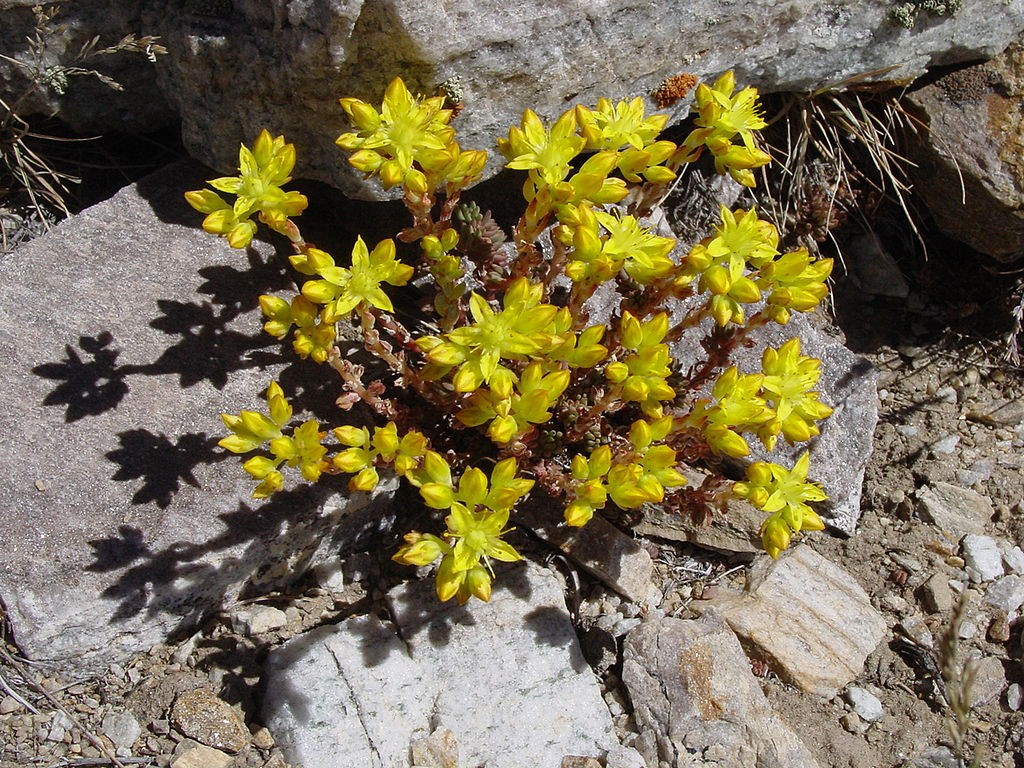 © Wikimedia.org/Wallace Keck, CC0
© Wikimedia.org/Wallace Keck, CC0
Leucanthemum × superbum, the Shasta daisy, is a commonly grown flowering herbaceous perennial plant with the classic daisy appearance of white petals (ray florets) around a yellow disc, similar to the oxeye daisy Leucanthemum vulgare Lam, but larger. It originated as a hybrid produced in 1890 by the American horticulturist Luther Burbank from a number of daisies. First, he crossed Leucanthemum vulgare with Leucanthemum maximum; this double hybrid was itself crossed with Leucanthemum lacustre. The resulting Leucanthemum triple hybrid was crossed with Nipponanthemum nipponicum, creating an intergeneric cross of species from three continents. It was named after Mount Shasta, because its petals were the color of the snow. Some members of the genus are considered noxious weeds, but the Shasta daisy remains a favorite garden plant. (Source: Wikipedia.org, CC BY-SA)
Silene is a genus of flowering plants in the family Caryophyllaceae. Containing nearly 900 species, it is the largest genus in the family. Common names include campion and catchfly. Many Silene species are widely distributed, particularly in the northern hemisphere. Silene undulata (syn. S. capensis) is known as iindlela zimhlophe ('white paths') by the Xhosa of South Africa. A Xhosa diviner identifies and collects the plant from the wild. The roots are ground, mixed with water, and beaten to a froth, which is consumed by novice diviners during the full moon to influence their dreams. They also take it to prepare for various rituals. The root has such a strong, musky essence that the diviners who consume it exude the scent in their sweat. (Source: Wikipedia.org, CC BY-SA)
Antirrhinum is a genus of plants commonly known as dragon flowers, snapdragons and dog flower because of the flowers' fancied resemblance to the face of a dragon that opens and closes its mouth when laterally squeezed. They are native to rocky areas of Europe, the United States, Canada, and North Africa. It is widely used as an ornamental plant in borders and as a cut flower. (Source: Wikipedia.org, CC BY-SA)
Galanthus (from Ancient Greek γάλα, (gála, 'milk') + ἄνθος (ánthos, 'flower')), or snowdrop, is a small genus of approximately 20 species of bulbous perennial herbaceous plants in the family Amaryllidaceae. The plants have two linear leaves and a single small white drooping bell-shaped flower with six petal-like (petaloid) tepals in two circles (whorls). The smaller inner petals have green markings. Snowdrops have been known since the earliest times under various names, but were named Galanthus in 1753. As the number of recognised species increased, various attempts were made to divide the species into subgroups, usually on the basis of the pattern of the emerging leaves (vernation). In the era of molecular phylogenetics this characteristic has been shown to be unreliable and now seven molecularly defined clades are recognised that correspond to the biogeographical distribution of species. New species continue to be discovered. (Source: Wikipedia.org, CC BY-SA)
Leucojum is a small genus of bulbous plants native to Eurasia belonging to the Amaryllis family, subfamily Amaryllidoideae. As currently circumscribed, the genus includes only two known species, most former species having been moved into the genus Acis. Both genera are known as snowflakes. (Source: Wikipedia.org, CC BY-SA)
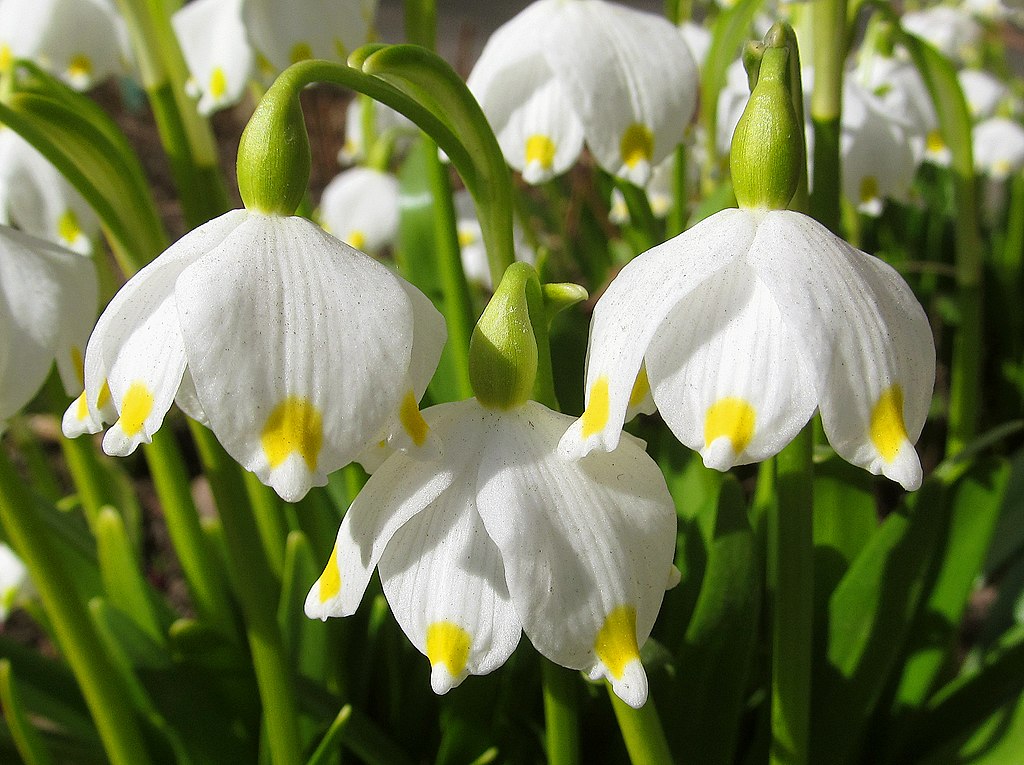 © Wikimedia.org/Tsyganov Sergey, CC BY-SA
© Wikimedia.org/Tsyganov Sergey, CC BY-SA
Solidago, commonly called goldenrods, is a genus of about 100 to 120 species of flowering plants in the family Asteraceae. Most are herbaceous perennial species found in open areas such as meadows, prairies, and savannas. They are mostly native to North America, including Mexico; a few species are native to South America and Eurasia. Some American species have also been introduced into Europe and other parts of the world. (Source: Wikipedia.org, CC BY-SA)
Veronica is the largest genus in the flowering plant family Plantaginaceae, with about 500 species. It was formerly classified in the family Scrophulariaceae. Common names include speedwell, bird's eye, and gypsyweed. Veronica americana is edible and nutritious, as are most species in the genus Veronica, and is reported to have a flavor similar to watercress. Native Americans used Veronica species as an expectorant tea to alleviate bronchial congestion associated with asthma and allergies.[according to whom?] The plant can be confused with skullcap and other members of the mint family. Members of the mint family have square sided stems, and Veronica species have rounded stems. (Source: Wikipedia.org, CC BY-SA)
Limonium is a genus of 120 flowering plant species. Members are also known as sea-lavender, statice, caspia or marsh-rosemary. Despite their common names, species are not related to the lavenders or to rosemary. They are instead in Plumbaginaceae, the plumbago or leadwort family. The generic name is from the Latin līmōnion, used by Pliny for a wild plant and is ultimately derived from the Ancient Greek leimon (λειμών, ‘meadow’). (Source: Wikipedia.org, CC BY-SA)
Oenothera is a genus of about 145 species of herbaceous flowering plants native to the Americas. It is the type genus of the family Onagraceae. Common names include evening primrose, suncups, and sundrops. They are not closely related to the true primroses (genus Primula). The species vary in size from small alpine plants 10 centimeters tall, such as O. acaulis from Chile, to vigorous lowland species growing to 3 meters, such as O. stubbei from Mexico. The leaves form a basal rosette at ground level and spiral up to the flowering stems. The blades are dentate or deeply lobed (pinnatifid). The flowers of many species open in the evening, hence the name 'evening primrose'. They may open in under a minute. Most species have yellow flowers, but some have white, purple, pink, or red. Most native desert species are white. Oenothera caespitosa, a species of western North America, produces white flowers that turn pink with age. One of the most distinctive features of the flower is the stigma, which has four branches in an X shape. (Source: Wikipedia.org, CC BY-SA)
The common sunflower (Helianthus annuus) is a large annual forb of the genus Helianthus grown as a crop for its edible oily seeds. Apart from cooking oil production, it is also used as livestock forage (as a meal or a silage plant), as bird food, in some industrial applications, and as an ornamental in domestic gardens. Wild H. annuus is a widely branched annual plant with many flower heads. The domestic sunflower, however, often possesses only a single large inflorescence (flower head) atop an unbranched stem. The plant was first domesticated in the Americas. Sunflower seeds were brought to Europe from the Americas in the 16th century, where, along with sunflower oil, they became a widespread cooking ingredient. With time, bulk of industrial-scale production has shifted to Eastern Europe, and (as of 2020) Russia and Ukraine together produce over half of worldwide seed production. (Source: Wikipedia.org, CC BY-SA)
 © Wikimedia.org/Jonson22, CC0
© Wikimedia.org/Jonson22, CC0
The sweet pea, Lathyrus odoratus, is a flowering plant in the genus Lathyrus in the family Fabaceae (legumes), native to Sicily, southern Italy and the Aegean Islands. It is an annual climbing plant, growing to a height of 1–2 metres (3 ft 3 in – 6 ft 7 in), where suitable support is available. The leaves are pinnate with two leaflets and a terminal tendril, which twines around supporting plants and structures, helping the sweet pea to climb. In the wild plant the flowers are purple, 2–3.5 cm (3⁄4–1+1⁄2 in) broad; they are larger and highly variable in color in the many cultivars. Flowers are usually strongly scented. (Source: Wikipedia.org, CC BY-SA)
Syringa is a genus of 12 currently recognized species of flowering woody plants in the olive family or Oleaceae called lilacs. These lilacs are native to woodland and scrub from southeastern Europe to eastern Asia, and widely and commonly cultivated in temperate areas elsewhere. They are small trees, ranging in size from 2 to 10 metres (6 ft 7 in to 32 ft 10 in) tall, with stems up to 20 to 30 centimetres (7.9 to 11.8 in) diameter. The leaves are opposite (occasionally in whorls of three) in arrangement, and their shape is simple and heart-shaped to broad lanceolate in most species, but pinnate in a few species (e.g. S. protolaciniata, S. pinnatifolia). (Source: Wikipedia.org, CC BY-SA)
Tagetes (/tæˈdʒiːtiːz/) is a genus of annual or perennial, mostly herbaceous plants in the family Asteraceae. They are among several groups of plants known in English as marigolds. The genus Tagetes was described by Carl Linnaeus in 1753. These plants are native to Mexico, growing naturally since Mexico's valley down to the south and even reaching several other Latinamerican countries, but some species have become naturalized around the world. One species, T. minuta, is considered a noxious invasive plant in some areas. (Source: Wikipedia.org, CC BY-SA)
Hybrid tea is an informal horticultural classification for a group of garden roses. The first hybrid tea roses were created in France in the mid-1800s, by cross-breeding the large, floriferous Hybrid Perpetuals with the tall, elegant Tea roses. The Hybrid tea is the oldest class of Modern garden roses. Hybrid teas exhibit traits midway between their parents, being hardier than the often delicate Tea roses, and with a better ability for repeat-flowering than the more robust Hybrid Perpetuals. Hybrid tea flowers are well-formed with large, high-centred buds, supported by long, straight and upright stems. Each flower can grow to 8–12.5 cm wide. Hybrid teas are the largest and most popular group of rose, due to their elegant form and large variety of colours. Their flowers are usually borne singly at the end of long stems which also makes them very popular as cut flowers. (Source: Wikipedia.org, CC BY-SA)
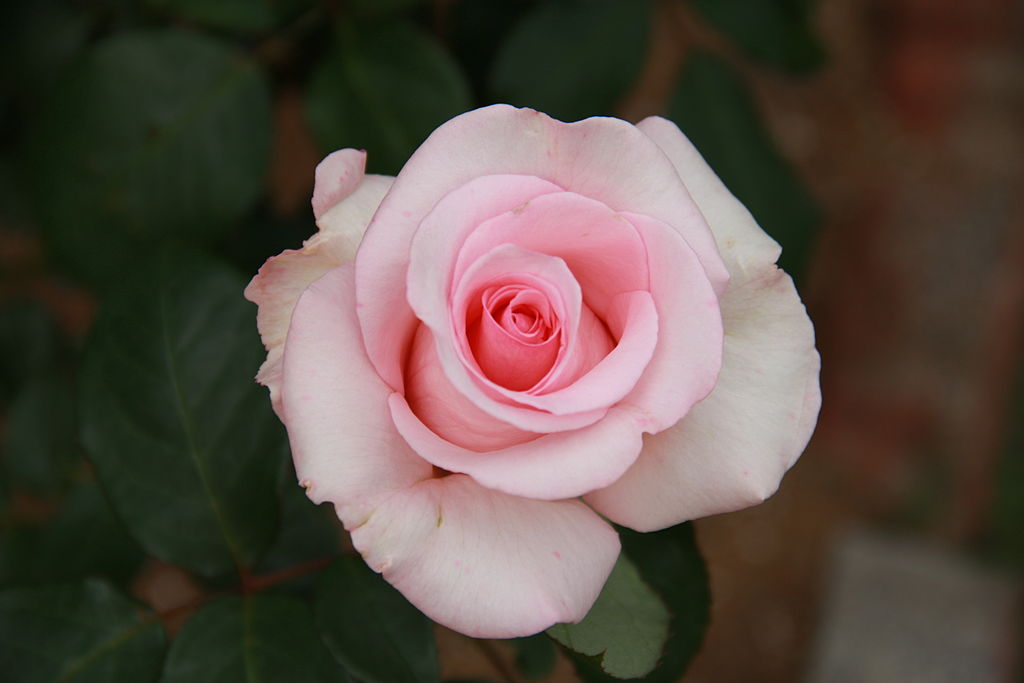 © Wikimedia.org/Arashiyama, CC BY-SA
© Wikimedia.org/Arashiyama, CC BY-SA
Thunbergia is a genus of flowering plants in the family Acanthaceae, native to tropical regions of Africa, Madagascar and southern Asia. Thunbergia species are vigorous annual or perennial vines and shrubs growing to 2–8 m tall. The generic name honours the Swedish naturalist Carl Peter Thunberg (1743-1828). Its members are known by various names, including thunbergias and clockvine. Thunbergia on its own usually refers to Thunbergia grandiflora, while Thunbergia alata is often known as black-eyed Susan vine or just black-eyed Susan (not to be confused with other flowers called black-eyed Susan). Orange clockvine is the name of Thunbergia gregorii. (Source: Wikipedia.org, CC BY-SA)
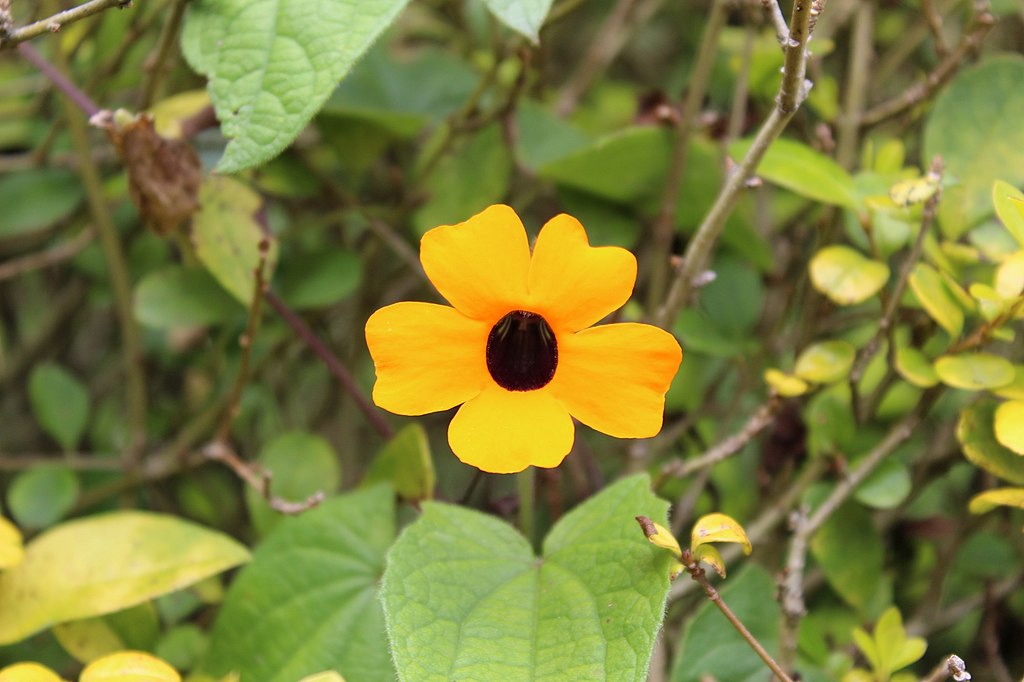 © Wikimedia.org/Nicolas Ramirez, CC BY-SA
© Wikimedia.org/Nicolas Ramirez, CC BY-SA
Tigridia /taɪˈɡrɪdiə/, is a genus of bulbous or cormous flowering plants belonging to the family Iridaceae. With common names including peacock flowers, tiger-flowers or shell flowers, they have large showy flowers; and one species, Tigridia pavonia, is often cultivated for this. The approximately 35 species in this family grow in the Americas, from Mexico to Chile. The tigridia flower is short lived, each often blooming for only one day, but often several flowers will bloom from the same stalk. Usually they are dormant during the winter dry-season. The roots are edible and were eaten by the Aztecs of Mexico who called it cacomitl, and its flower ocēlōxōchitl 'jaguar flower'. The genus name Tigridia means 'tiger-like', and alludes to the coloration and spotting of the flowers of the type species Tigridia pavonia. (Source: Wikipedia.org, CC BY-SA)
Lilium lancifolium (syn. L. tigrinum) is an Asian species of lily, native to China, Japan, Korea, and the Russian Far East. It is widely planted as an ornamental because of its showy orange-and-black flowers, and sporadically occurs as a garden escapee in North America, particularly the eastern United States including New England, and has made incursions into some southern states such as Georgia. It has the English name tiger lily, but that name has been applied to other species as well. (Source: Wikipedia.org, CC BY-SA)

Time for recess! Post a comment, ask a question or write a review. Feel free to let us know what you think!
Most problems are a result of higher than safe driving speeds. Please just slow down and be patient.
Question 121: Poor translation: Vehicles with polluted fluids prohibited Should be translated as: Vehicles with dangerous liquids prohibited
Question 83: Poor translation: Vehicles with polluted fluids prohibited Should be translated as: Vehicles with dangerous liquids prohibited
Want even more practice? Visit similar websites offering realistic practice driving knowledge tests. Visit us to see what sets our tests apart! https://dkttest.com/capital-territory/
Cool tool! And fun to check whether I remember the rules :) Two things I noticed: Warning for a crossroad side roads on the left and right. While technically that might be the correct translation, this sign tells you, that you are on the main road and have the right of way for the next crossroad and only the next crossroad. Usually (if no sign specifies otherwise) you have to give way to drivers coming from the right at every intersection, which can get a bit annoying in communal areas, so seeing this sign feels less like a warning and more like relief :). A Fahrradstraße is not a lane for cyclists but a street for cyclists, meaning the (whole!) street is intended predominantly for cyclists, who are then allowed to ride next to each other. Cars are allowed to drive there (unless another sign prohibits such), but have to adjust their speed to the cyclists. I believe they are not allowed to pass at all, even if the oncoming lane is empty.
this website is a simpy website i love this its fat and im in my mums basement rn help sui u r a mothr fker
Hi i am such fat fan of this great gaming website. Im so hangry for the cause mate! Liking the simps eating on yall tho nott gonna lie to ya!
The system is now changed and they use some type of tablet for the exam now. Do anyone have the questions which they ask in the tablet because the questions are different. I still didn’t pass my provisional driving knowledge test. It would be great if someone could help
Good exercise !! Looking for some drift friends, hit to my email Funnyparts@gmail.com
More community